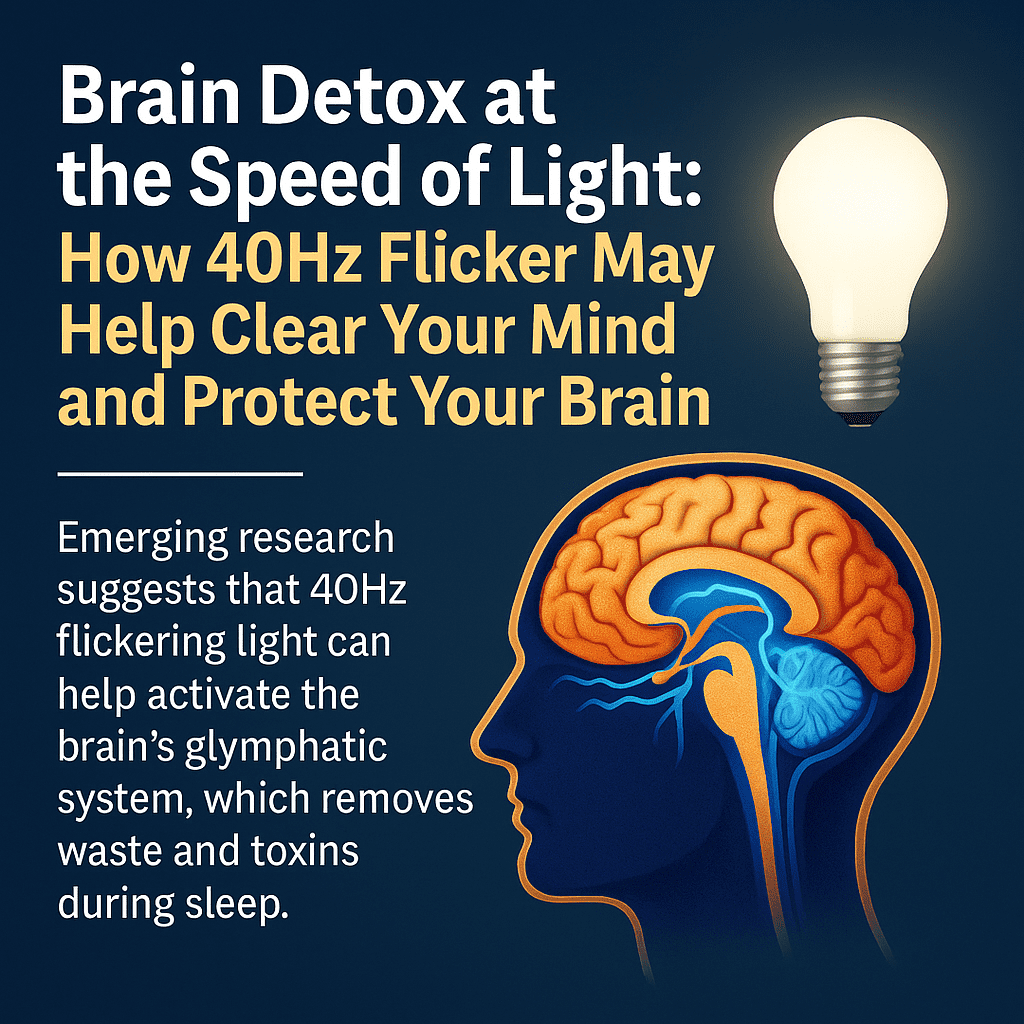When you think of detoxing your brain, you might imagine meditation, sleep, or cutting out sugar. But what if the solution could come in the form of a lightbulb?
Emerging research suggests that 40 Hz light flicker therapy may promote brain health in a powerful new way—by activating the brain’s glymphatic system, the body’s internal “waste disposal” network for the mind.
🧠 What Is the Glymphatic System—and Why Should You Care?
The glymphatic system is a fluid clearance pathway in the brain that removes waste, toxins, and misfolded proteins—like amyloid-β, tau, and α-synuclein—which are known culprits in Alzheimer’s and Parkinson’s disease.
This system works most efficiently during deep sleep, when cerebrospinal fluid (CSF) flows through perivascular spaces, flushing out interstitial fluid (ISF) and carrying brain waste to drainage sites.
In other words, when you’re in deep sleep, your brain’s blood vessels shrink a bit, which creates extra space around them.
This lets a special fluid (CSF) flow through and rinse out the waste and toxins that build up while you’re awake — kind of like a nighttime car wash for your brain.
But here’s the catch: as we age, or if we suffer from conditions like Type 2 Diabetes, hypertension, or chronic sleep deprivation, this system can slow down or become dysfunctional—potentially contributing to neurodegeneration.
💡 Enter 40 Hz Light Flicker: A Bright Idea for Brain Health
Groundbreaking animal studies have shown that exposing the brain to 40 Hz flickering light can:
- Enhance glymphatic clearance
- Improve cognition
- Reduce amyloid plaque accumulation in Alzheimer’s models
This frequency mimics gamma brain wave activity, which is naturally linked to focused attention and healthy memory function. In Alzheimer’s disease, gamma activity is significantly impaired.
By stimulating gamma oscillations, light flicker therapy may reset the rhythm of the brain’s clean-up crew.
🔬 How It Works: Blood Vessels, Brain Waves, and Water Channels
Studies such as Murdock et al. and Kylkilahti et al. show the deep interplay between vascular health, pulsatility, and CSF flow.
For the techies, here’s a breakdown of the mechanism:
- Gamma flicker stimulation (40Hz) increases activity in VIP interneurons, which modulate arterial pulsation—key to pushing CSF through the brain.
- It enhances the polarization of Aquaporin-4 (AQP4) channels on astrocyte endfeet, improving water transport efficiency in the glymphatic pathway.
- It may even help “reset” circadian-linked brain clearance processes disrupted by aging or disease.
This is why sleep, vascular health, and light exposure all matter so much—and why light therapy might be the missing piece.
Sleep & Light: A Powerful Duo
Want to boost your brain detox?
Pairing deep sleep with evening 40Hz gamma light therapy could act synergistically. During sleep, blood vessels constrict, increasing space around them and allowing CSF to wash away brain waste more effectively.
Adding gamma flicker to the mix may amplify this natural rhythm, like tuning your brain’s internal housekeeping system.
🛒 Ready to Try 40 Hz Light Therapy?
Several products on the market today are designed to emit 40 Hz flickering light, such as this Gamma Light Therapy 40Hz Bulb on Amazon. (UK visitors) Easy to use, you simply screw it into a standard lamp, switch it on in a dark room, and allow your mind and body to sync with the gentle flicker. USA Visitors click here
Tips for use:
- Try 1 hour in the evening while relaxing or reading
- Use consistently for several weeks to notice cognitive benefits
- Combine with sleep hygiene, vascular health habits, and a clean diet for maximum effect
🧬 The Future of Neurodegenerative Prevention?
While clinical research in humans is still developing, the early data is promising. Modulating brain rhythms with gamma light therapy may one day become a powerful non-invasive treatment for Alzheimer’s, Parkinson’s, and even long-term brain fog.
As scientists uncover more about the glymphatic system, our understanding of brain health, light, and longevity continues to expand.
And the best part? You can get started tonight—with the flip of a switch.
✅ Available now on Amazon:
🛒 Every purchase through these links helps support the site — thank you!
How to Pick the Best Red Light Therapy Device for Pain Relief
Is Natural Sunlight Enough to Improve Blood Sugar Like Red Light Therapy?
How Long Should You Use Red Light Therapy for Blood Sugar?
What Wavelength of Red Light Is Best for Blood Sugar Support?
Does Red Light Therapy Improve Insulin Sensitivity?
Can Red Light Therapy Help with Diabetic Neuropathy?
Quiz: Understanding Brain Clearance and Neurodegenerative Diseases
The glymphatic system is a mechanism for brain clearance, removing toxic metabolites and waste products via a perivascular cerebrospinal fluid (CSF) flow pathway.
Alzheimer’s disease (AD) and Parkinson’s disease (PD) are mentioned as common neurodegenerative diseases linked to toxic protein accumulation.
The glymphatic system plays a role in the clearance of these specific proteins, which are found in the cerebrospinal fluid.
The cardiac cycle drives the macroscopic CSF flow, with CSF efflux peaking during systole and reflux peaking during late diastole.
The researchers used 7 Tesla magnetic resonance (7 T MR), specifically 2D Phase Contrast MR (2D PC MR), to visualize and quantify CSF flow.
These conditions may exacerbate disturbances in CSF flow due to decreased vascular compliance and subsequent high vascular pulsatility, potentially leading to dysfunctional CSF-mediated brain clearance.
When blood vessels constrict, generally during sleep, it creates space between the vessel and brain tissue, allowing for increased CSF flow to wash away waste.
40 hertz (Hz) light flickers have been shown to have these effects.
Multisensory gamma stimulation increases aquaporin-4 (AQP4) polarization along astrocytic endfeet.
VIP interneurons facilitate glymphatic clearance by regulating arterial pulsatility and potentially releasing neuropeptides.
Glossary of Key Terms
Amyloid-β: A protein fragment that, in excess or when misfolded, can accumulate in the brain and is a key pathological feature of Alzheimer’s disease.
Aquaporin-4 (AQP4): Water channels located on astrocytes, particularly at their endfeet surrounding blood vessels, that play a critical role in facilitating the movement of water and fluid within the glymphatic system.
Astrocytes: Star-shaped glial cells in the brain that provide support to neurons and are involved in various functions, including regulating the glymphatic system.
Cerebral Aqueduct: A narrow channel that connects the third and fourth ventricles of the brain, through which cerebrospinal fluid flows.
Cerebrospinal Fluid (CSF): A clear fluid that surrounds the brain and spinal cord, providing cushioning and playing a crucial role in brain clearance via the glymphatic system.
Glymphatic System: A functional waste clearance pathway in the brain that facilitates the removal of metabolic waste products and soluble proteins, including those associated with neurodegenerative diseases, via a perivascular fluid exchange mechanism involving CSF and interstitial fluid.
Interstitial Fluid (ISF): The fluid that surrounds cells in the brain tissue. In the glymphatic system, there is an exchange between CSF and ISF to facilitate waste removal.
Neurodegenerative Diseases: Progressive conditions characterized by the degeneration and death of neurons in the brain, leading to impaired cognitive function and movement disorders, such as Alzheimer’s and Parkinson’s diseases.
Perivascular Spaces (or Paravascular Spaces): The spaces surrounding blood vessels in the brain where the exchange of CSF and ISF occurs in the glymphatic system.
Proteinopathies: Diseases characterized by the misfolding, mis-localisation, or toxic accumulation of specific proteins in the brain, often leading to neuronal dysfunction and loss, as seen in many neurodegenerative diseases.
Pulsatility: The rhythmic expansion and contraction, particularly of blood vessels, driven by the cardiac cycle. This pulsatile action is important for driving fluid flow in the glymphatic system.
7 Tesla Magnetic Resonance (7 T MR): An ultra-high field magnetic resonance imaging technique used to obtain high-resolution images and quantify physiological processes, such as CSF flow.
Vasoactive Intestinal Peptide (VIP): A neuropeptide found in VIP interneurons that has been implicated in regulating various physiological processes, including blood vessel diameter and potentially influencing glymphatic clearance.
Amazon Affiliate Disclaimer
As an Amazon Associate, I earn from qualifying purchases.
This means that if you click on a product link and make a purchase, I may receive a small commission at no extra cost to you. This helps support the site and allows me to continue providing helpful content. Thank you for your support!






